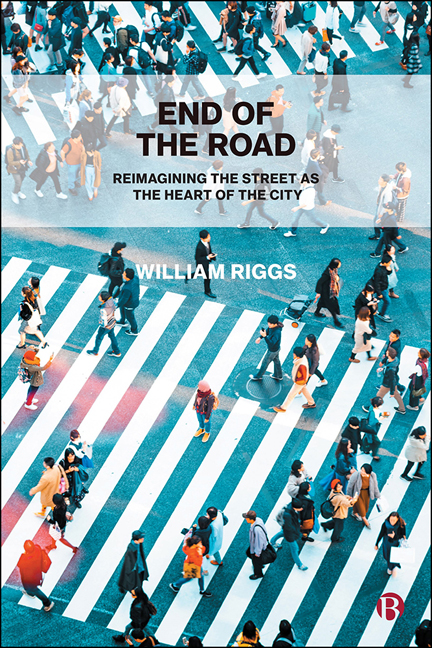Book contents
- Frontmatter
- Dedication
- Contents
- List of Figures and Tables
- Acknowledgments
- 1 Introduction
- 2 A Recent History of the Street
- 3 The Street for Transport
- 4 The Street as Economic Space
- 5 The Street as Social Space
- 6 The Street as Cultural Space
- 7 The Street as a Natural Space
- 8 Challenges to Ending the Road
- 9 Beyond Streets: Integrating Behavior
- 10 A Window into the Future: New Vehicles, New Streets
- 11 A Call to Action: Streets as the Heart of the City
- Appendix
- Notes
- References
- Index
11 - A Call to Action: Streets as the Heart of the City
Published online by Cambridge University Press: 12 October 2022
- Frontmatter
- Dedication
- Contents
- List of Figures and Tables
- Acknowledgments
- 1 Introduction
- 2 A Recent History of the Street
- 3 The Street for Transport
- 4 The Street as Economic Space
- 5 The Street as Social Space
- 6 The Street as Cultural Space
- 7 The Street as a Natural Space
- 8 Challenges to Ending the Road
- 9 Beyond Streets: Integrating Behavior
- 10 A Window into the Future: New Vehicles, New Streets
- 11 A Call to Action: Streets as the Heart of the City
- Appendix
- Notes
- References
- Index
Summary
When we speak of the “environment”, what we really mean is a relationship existing between nature and the society which lives in it. Nature cannot be regarded as something separate from ourselves or as a mere setting in which we live. […] We are faced not with two separate crises, one environmental and the other social, but rather with one complex crisis which is both social and environmental. (Pope Francis, Laudato Si’ On Care for Our Common Home, 2015)
If part of what cities need to do is become antifragile and embrace streets not roads, then how do we do this? We’ve spent time talking about the history, methods and rationale for a new way to think about roads. In sum, I’ve argued that we can kill the concept of the road and potentially reinvigorate cities through a new vision for streets. But, particularly in an era where we face an unprecedented need to restore the environmental sanctity and social justice of our cities, I think it is important to consider how we take action. It is import that we do as Pope Francis suggests in his recent encyclical and not separate environment and social challenges.
So how do we do this? In my experience, while plans and visions are important, they are simply words until we (citizens, policy makers, engineers and planners) take unabashed actions, exercise leadership and use management inertia to make change. And there is so much work to do to change that we need to make a start on our streets and in our cities. There are so many streets that are not friendly to walking and biking. There are so many roadways that are hostile to public discourse and transactional exchanges. There are many streets where we need to take action on both environmental and social challenges.
I have spent a large portion of my career focused on trying to reinvigorate a dialogue about how streets can be a catalyst for change. I observed forms of social segregation and environmental marginalization as central cities gentrified and have long argued that walkable places need to become more available to poor and minority populations. In this light, I have always been careful to say that economic development and gentrification are not necessarily the problem, but when uncontrolled they can be a symptom and have negative consequences.
- Type
- Chapter
- Information
- End of the RoadReimagining the Street as the Heart of the City, pp. 144 - 157Publisher: Bristol University PressPrint publication year: 2022

